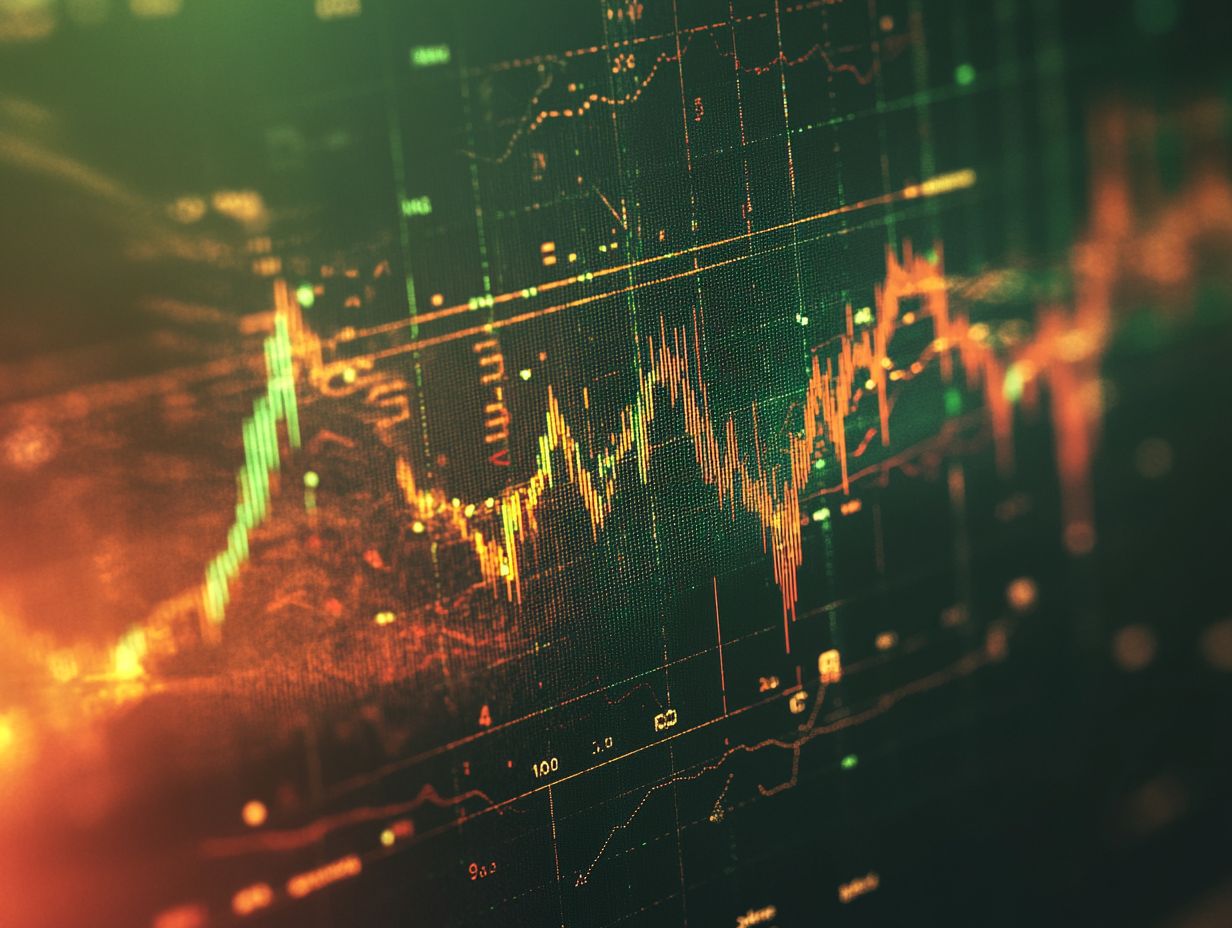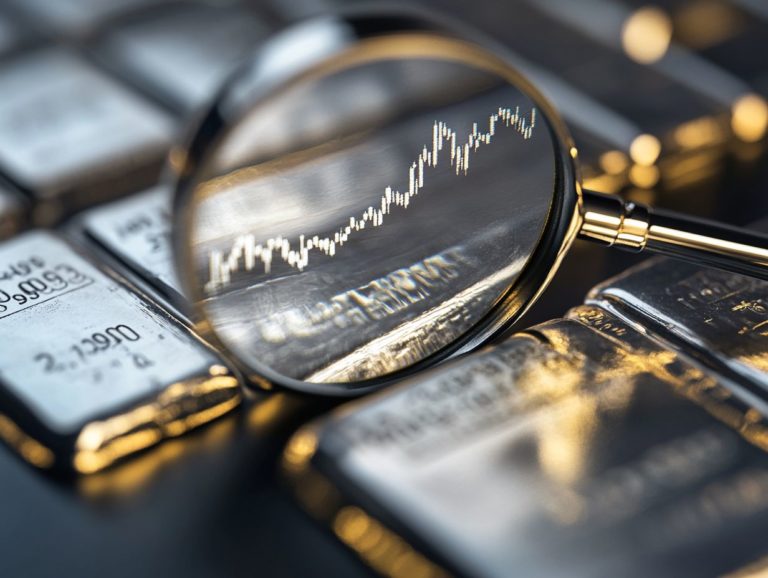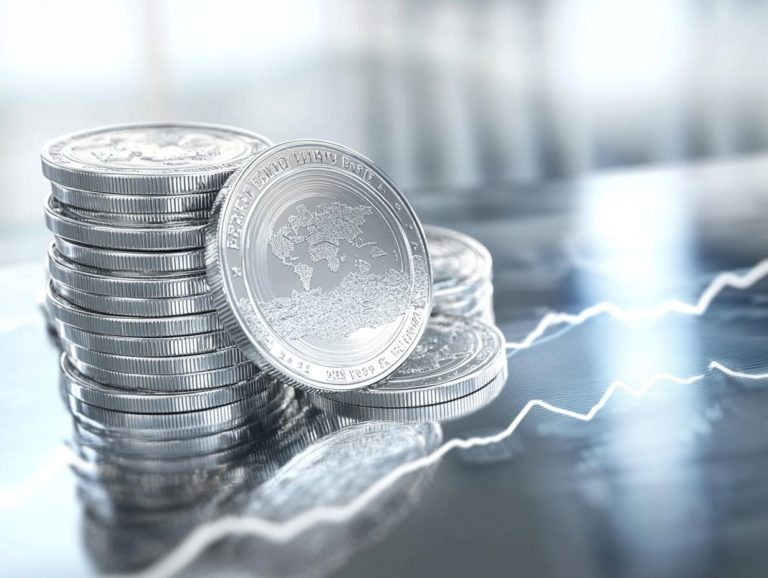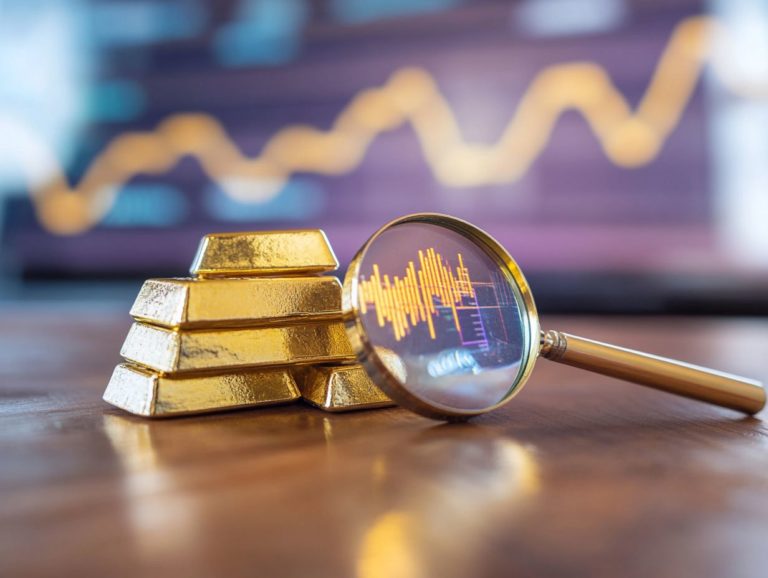Gold Price Trends: Analysis for Investors
Gold has always been a trusted safe haven for investors. Grasping its price trends is essential for making informed decisions.
Numerous factors sway gold prices, ranging from economic indicators to geopolitical events. This discussion delves into historical patterns and current market fluctuations. You’ll gain valuable insights into effective investment strategies.
Whether you re a seasoned investor or just beginning your journey, you ll discover how to navigate the gold market. You can also explore alternative investments to create a well-rounded portfolio.
Dive into the complexities of gold investment with us as we unravel the intricacies together.
Contents
Key Takeaways:

- Gold prices are influenced by factors such as supply and demand, global economic conditions, and political instability.
- Historical analysis reveals that gold prices have shown consistent growth in the long term, with periodic fluctuations.
- Investors should carefully consider their goals and risk tolerance when investing in gold. It’s also important to explore alternative options for diversification.
Understanding Gold Price Trends
Grasping gold price trends is crucial for you as an investor aiming to navigate the intricate landscape of the gold market. This market reflects a variety of economic factors, including inflation, currency fluctuations, and global demand, especially from significant players like China, India, and Russia.
By examining historical gold prices, you can uncover patterns that inform your investment strategies. You can pinpoint price support levels, which are points where prices tend to stop falling and may start to rise. This knowledge helps you make well-informed decisions regarding your investment portfolio.
Factors that Influence Gold Prices
Several factors influence gold prices, including fluctuations in the value of the US dollar, demand from central banks, inflation rates, and geopolitical tensions. These elements interact in complex ways, shifting the global gold demand and supply dynamics.
For example, when the US dollar weakens, gold often shines brighter as an alternative investment. Historical instances show that during economic instability, central banks tend to bolster their gold reserves. This drives prices up due to increased demand.
Inflation often reduces purchasing power, prompting investors to seek gold as a safeguard against currency devaluation. Recent geopolitical tensions such as trade wars or conflicts in resource-rich areas create uncertainty that impacts gold’s allure and its price.
Historical Analysis of Gold Prices
A historical analysis of gold prices unveils significant trends and patterns that have influenced its value over time.
This is particularly evident during economic crises, such as those experienced in 1980 and in the wake of the COVID-19 pandemic. These events led to unprecedented price increases and fluctuations in gold demand, reflecting its role as a safe-haven asset in turbulent times.
Key Trends and Patterns

When you analyze the history of gold prices, key trends and patterns begin to surface. These reveal how external factors like inflation, currency fluctuations, and global demand shape the market. Recent gold price charts illustrate these significant fluctuations beautifully.
Over the past few decades, these variables have been pivotal in defining gold’s value as a safe-haven asset. For instance, during times of economic uncertainty, investors commonly gravitate towards gold. This drives its price upward, as evidenced by historical spikes on the charts. The inverse relationship between gold prices and a strengthening US dollar highlights how market sentiment shifts, impacting your timing for entry and exit strategies.
By examining these trends, you can align your investment objectives with the current market conditions. This leads to more informed decisions in today s ever-evolving economic landscape.
Are you ready to explore these exciting investment opportunities?
Current State of the Gold Market
The current state of the gold market reveals a sophisticated interplay of factors. Recent fluctuations are largely influenced by an uptick in gold demand, driven by escalating geopolitical tensions and economic uncertainties.
These dynamics intricately shape your trading strategies and the market prices you encounter.
Recent Fluctuations and Predictions
Recent fluctuations in gold prices have sparked a wave of forecasts that you should consider when evaluating future market conditions.
These changes, driven by factors like geopolitical tensions, inflation rates, and shifts in currency strength, point to a broader economic landscape that deserves your attention.
Analysts observe that as central banks adjust interest rates and market confidence wavers, gold often emerges as a safe haven.
Expert insights reveal a strong correlation between economic uncertainty and rising gold prices. Some predict a continued upward trend in the coming months.
Stay informed about global economic indicators and local market dynamics to make astute investment decisions in the gold sector.
Investing in Gold
Investing in gold can be a smart way to diversify your investment portfolio. You have several options, from directly owning physical gold to investing in gold exchange-traded funds (ETFs).
The latter offers you exposure to gold without the hassle of storage. This allows you to leverage price analysis for informed decision-making.
Strategies for Maximizing Returns

Maximizing your returns on gold investments demands a thoughtful strategy that aligns with your individual investment goals.
Keep a keen eye on gold price trends and forecasts to seize potential price increases.
You can significantly enhance your investment outcomes by employing various strategies. This includes analyzing historical price movements and understanding the macroeconomic factors large-scale economic factors affecting the overall economy that sway the gold market.
By effectively timing your entry and exit points, you can amplify your potential gains.
Utilizing tools like price alerts and market analysis provides valuable insights. This proactive approach helps mitigate risks and ensures your gold investments align with broader financial goals.
Ultimately, this creates a more balanced and resilient investment portfolio in the face of fluctuating market conditions.
Considerations for Different Types of Investors
As an investor, it’s vital to consider your unique needs and risk tolerance when venturing into gold, whether through physical assets or gold ETFs.
Key factors such as gold storage, liquidity, and diligent market analysis play significant roles in your investment journey.
For individual investors, the strategy often revolves around personal financial goals and the desire to hedge against inflation.
On the other hand, institutional investors typically focus on larger capital allocations and long-term portfolio stability.
It’s vital to understand the risk management strategies that fit your style. You may prefer smaller, more flexible investments, while institutional players often opt for diversified portfolios to spread out risk.
Your investment horizon can dramatically influence your decisions. If you re a short-term trader, you might react swiftly to gold price fluctuations.
In contrast, long-term holders tend to analyze trends for strategic entry points.
By leveraging comprehensive gold price analysis, you can elevate your strategic decision-making and tailor your investments to fit specific market conditions and economic forecasts.
Alternative Investments to Gold
Exploring alternative investments beyond gold opens up valuable opportunities for diversifying your investment portfolio.
This is particularly important during inflationary periods, when gold price trends may not align with other asset classes.
Embracing a broader array of investments can enhance your financial strategy and help mitigate risks.
Start diversifying your investments today to shield against future uncertainties!
Exploring Other Options for Diversification
When you think about diversification, consider a variety of alternative investments beyond just gold. Options like real estate, bonds, and even cryptocurrencies bring unique benefits and risks.
Integrating these diverse assets into your portfolio can enhance stability and potentially lead to higher returns. For instance, real estate delivers consistent cash flow, serving as a solid hedge against inflation.
Bonds help reduce volatility and can improve your returns relative to risk. Cryptocurrencies provide high-risk, high-reward opportunities for those ready to navigate the unpredictable digital market.
Incorporating these assets not only complements your gold holdings but also fosters a resilient investment strategy that balances growth and stability.
Frequently Asked Questions

What are some factors that influence gold prices?
Several factors can influence gold prices, including economic conditions and investor sentiment. Geopolitical events and currency movements also play significant roles.
How often do gold prices change?
Gold prices can change daily due to various market factors. Significant fluctuations may occur over longer periods, such as months or years.
Why do investors consider gold a safe-haven asset?
Many investors turn to gold when the market gets shaky, knowing it s a reliable store of value. It has maintained its worth during economic uncertainty.
How can I track gold price trends?
You can track gold price trends through financial news websites and market analysis reports. Online platforms specializing in precious metals are also useful, along with monitoring gold-related instruments like ETFs or mining stocks.
What are the benefits of including gold in my investment portfolio?
Gold provides diversification benefits, often having a low correlation with stocks and bonds. It also acts as a hedge against inflation and offers protection during economic uncertainty.
What are the risks of investing in gold?
Investing in gold comes with risks such as price volatility and potential liquidity issues. Fraud and scams are other concerns in the gold market, so thorough research is crucial!















